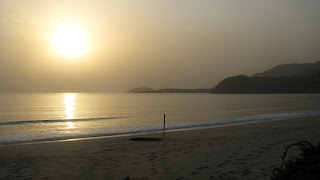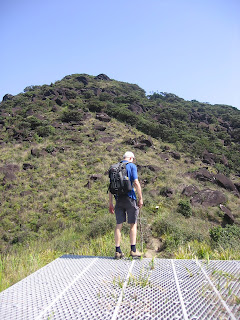 Caleb signing the log alongside a plague at the Stinson Crash Site
Caleb signing the log alongside a plague at the Stinson Crash Site
 All that is left of the plane wreckage is a few twisted pieces of indistinguishable metal that might as well be a tractor.
All that is left of the plane wreckage is a few twisted pieces of indistinguishable metal that might as well be a tractor.
DESCRIPTION:
Lamington National Park mainly consists of rough rainforest terrain with pockets of all sorts of noxious weeds such as the nasty Lawyer Vine. Most of the rain in the Park blows in from the ocean and so areas on the coastal side of the Park have a much higher annual rainfall than those to the west. Although the term jungle is not used commonly to describe the Australian bush, areas near the McPherson Range (the highest eastern points) within Lamington National Park are close as you will get, apart from the tropical regions of Northern Queensland.
As the Stinson crash site is 1 km to the north west of Point Lookout (1085m) on the McPherson Range, it is still quite close to the higher rainfall areas. Like much of Lamington, the walk in from Christmas Creek is mostly under the canopy through thick, steep and often wet bushland.
One reason for doing The Stinson Walk seems to be viewing the remains of the Stinson aircraft that crashed on 19 February 1937 while enroute from Brisbane to Sydney. If this is your primary motivation then you will probably be disappointed as 70 + years of erosion have taken a serious toll on its remains. A more enduring inspiration is to undertake the walk mindful of the courage, stamina and bushcraft of all involved in the subsequent rescue.
Nine days after the crash local resident Bernard O'Reilly set off to look for the wreckage and any survivors. He plotted a course based on a knowledge of the plane's flight path and his conviction that it had most likely struck one of the highest points along the McPherson Range and crashed in the surrounding dense bushland. He spent the first night sleeping rough and on the second day climbed Mt Throakban (1140m) from where he spotted evidence of a yellow patch in the forest that he concluded must have been a caused by fire. Using a high degree of bush sense he navigated 8km in around 8 hours to the crash site finding two survivors, John Proud and Joe Binstead.
They reported four men had died in the crash (including both pilots) and that a third survivor, Jim Westray had set off to fetch help by attempting to follow the upper tributaries of Christmas Creek out to the western farmlands below. As this was the shortest way out to raise the alarm, Bernard O'Reilly also used this route and tragically discovered Jim Westray's body. Westray had fallen to his death down one of the three steep waterfalls in the upper reaches of the watercourse and his nearby grave is located in close proximity to the Christmas Creek walking track.
Bernard O'Reilly 's raised the alarm among local farmers and returned back up Christmas Creek with a rescue party journey, while other farmers blazed a trail to the crash site on the Stretcher Track, as Christmas Creek as deemed to difficult an evacuation route.
Bernard O'Reilly's original 36km journey from O'Reilly's Rainforest Guesthouse to the crash site and out via Christmas Creek can be completed as a guided one day or overnight walk. Peter and Tim O'Reilly (grandsons of the legendary Bernard) conduct these walks ranging from 8 - 36 km: http://www.oreillys.com.au/lamington-national-park/bushwalking/full-day-walks/. Other credible tour guides also conduct a variety of walks to the Stinson crash site from O'Reilly's and Christmas Creek: http://www.worthwild.com.au/adv/bushwalking/bushwalking.htm
The walk we describe below is the 8km return trip from Christmas Creek. This can easily be extended to 10km by incorporating Point Lookout, which is 2 km return beyond the Crash Site.
A further variation is to ascend via the Christmans Creek route and descend on the Stretcher Track which leads back to the Christmans Creek Memorial Park Campground. To avoid walking 5 uneventful kilometres from the Campground to the start of the Christmas Creek walk, a car pool can be arranged.
Hema Maps detail the walks into the Stinson Crash site quite well on their Lamington National Park map. These cost about $10 and are easily ordered through World Wide Maps in Edward St, Brisbane City: http://www.worldwidemaps.com.au/ Local postage cost is about $3.
LOCATION:From Brisbane take the Mt Lindesay Highway south to Beaudesert (60 km). In Beaudesert turn right following the Rathdowney sign. After 15 km turn off th Mt Lindesay Highway into Christmas Creek Road at Laravale. Follow Christmas Creek Road for 30 km to the Christmas Creek Recreation Camp and the Stinson Memorial Park Campground. Gap Creek Road runs off to the south opposite the Recreational Camp and is used only if you are using the Stretcher Track.Proceed along Christmas Creek Road which becomes a one lane dirt road after 1.5km. Proceed with care for a further 4 km crossing a small concrete bridge and parking in one of the two areas at the end of the road.
TRACK NOTES:
As indicated earlier the walk described is the 8km return Stinson Crash Site via Christmas Creek. This is easily extended to 10km by adding the 2km return to Point Lookout (1085m).
To make this a circuit walk there is the option of ascending on the Christmas Creek track to the Stinson Site and descending on the Stretcher Track. The section from the western end of the Stretcher Track to the end of Gap Creek Road is private property and permission must be gained to enter it via the Park Rangers. This is sometimes completed over 2 days using a campsite near the Stretcher Track turnoff (1110m).
When planning a walk in this area of Lamington it is always advisable to contact the Park Rangers to check local conditions, book campsites and ask about entering private property. Telephone: 07 5544 0634.
Stinson via Christmas Creek Return
Walk through the gate to the east of the carpark (340m) and continue on the track until it drops into Christmas Creek. Rock hop up the creek, crossing where safe to pick up the distinct track on the southern side. After heavy rain hikers often walk or shimmy across a massive log which provides access to the southern side of the creek. Another option is to cross back over the bridge near the carpark to pick up a rough track leading to the main footpad. Whatever option you use to start the main track is on the southern side of Christmas Creek and runs adjacent to it.Minor deviations can be taken during the first 2 km which either connect back into the main track or become too thick to continue. If ever in doubt keep the creek on your left during this first phase and continue until encountering the sign to Westray's Grave, which is a short deviation from the main track. This area is quite a pleasant location for a break.After returning to the main track from Westray's Grave (475m) the track swings steeply uphill for 700m in which 300m altitude is achieved (approx 40 degrees). This is the first good test of the fitness level of your group and any more than one stop on this section should be avoided, especially if you have started after 9am. As the vast majority of the walk is under the canopy the recommended finish time is no later than 5pm in summer and 4pm in winter as the forest does become dark well before sunset.After the uphill slog the track flattens out considerably and a small scramble gives way to filtered ridgeline offering minimal views but the best on offer for the day. This is recommend as the second rest stop (755m).After a brake continue on the well defined track for approximately 500 metres to where the vegitation becomes thinner and allows more filtered light onto the forest floor. From this point this section begins to become criss crossed with different variations on the same track. It is worth marking your route in this section to save time on the descent. Continue for 250 metres until a clearing is reached (985m) with three distinct tracks running off in different directions.
From the approach track to the clearing the left hand (northerly) track leads down to the remains of the Stinson. The track opposite (south west) leads to Point Lookout (1085m) and the main Border Ranges Track which winds for many kilometres along the top of the McPherson Range. This also connects with the Stretcher Track which can be used as a circuit back to Gap Creek Road at the western end of the National Park.
Due care must be taken in this section of the Park as it is easy to become temporarily bushwacked which wastes time and creates unnecessary emotional discomfort. Be sure to keep your group together at all times during this walk as visibility ranges from 50 metres at best down to 5 metres in some places. It's a good day out when everyone walks out. Lamington does not need anymore grave sites.
This route is a walk and no technical skills are required. As no ridgelines or serious scrambles come into play there is no real risk of injury due to falls. Threats are more likely to come in the form of a twisted ankles or becoming disorientated in thicker sections of the forest. Manage this risk by:
- checking local conditions with Rangers prior to departure
- take a topographic map and compass (and GPS)
- be adequately prepared with equipment and supplies to deal with unexpected variables
PROVISIONS:
To Wear:
* Hat
* Sunnies (optional)
* Good quality walking / running / hiking shoes in good condition.
* Gaiters are a useful addition
Hiking Pack: 35 - 45 litres is an ideal sized day-pack for this walk due to the thickness of the bush.
* 3l Water (minimum or more if you drink a lot)
* Food for snacks and lunch on the summit:
- Sizeable lunch of sandwiches / pasta / etc
- Muesli bars- Fruit (fresh or dried)
- Chocolate
* Basic First Aid Kit including:
- Sunscreen
- Insect repellent
- Bandaids
- Pressure bandage
- Elastic ankle support
- Paracetamol
- Personal medications
- Basic first aid book
* Topographic Map (1:25,000) and Compass
* Mobile Phone (fully charged)
* 10 metres of good quality rope
* Wet weather gear:
- Spray jacket with hood
* Cold weather gear:
- Space blanket
- Jacket
- Long trousers
- Beanie (head warmer)
- Gloves
- Flint or Matches (waterproof) in case of emergency
* Head lamp and Batteries
* Shovel and toilet paper
Optional Equipment:
* Camera & Batteries
* GPS
* Change of shirt / clothes for the return car ride (to leave in the car)HISTORY:
HISTORY: The Internet is rich with information on Lamington National Park and the Stinson Crash. Some of the more useful links with original photographs and news articles include:
http://www.archives.qld.gov.au/research/stinson.asphttp://www.oreillys.com.au/about-us/o-reilly-s-story/the-stinson-rescue/http://lamington.nrsm.uq.edu.au/Documents/Other/stin.htmThis walk is popular with historians, aviators, defence force and emergency services personal probably due to the inspiration they gain from the effort of all involved in the survival and rescue. As scramblers who love nothing more than a clean climb up some nice rock slabs Lamington is not exactly our cup of tea, however it is worth doing a least once as a mark of respect to the courage shown by all involved during those 12 days in 1937.







































